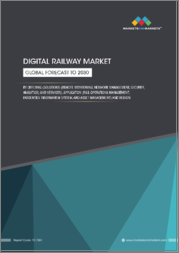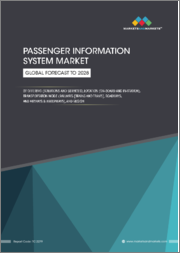
|
시장보고서
상품코드
1642529
세계의 승객 정보 시스템 시장 보고서 : 교통수단, 구성요소, 시스템 유형, 위치, 지역별(2025-2033년)Passenger Information System Market Report by Mode of Transport, Component, System Type, Location, and Region 2025-2033 |
||||||
승객 정보 시스템 시장 세계 시장 규모는 2024년 292억 달러에 달했습니다. 향후 IMARC Group은 2033년까지 시장 규모가 690억 달러에 달하고, 2025-2033년간 9.55%의 연평균 성장률(CAGR)을 나타낼 것으로 예측했습니다. 시장의 주요 원동력은 급격한 도시화로 인한 스마트시티 구상 증가, 대중교통에 대한 정부 투자 증가, 비용 효율성과 확장성을 중시하는 클라우드 기반 솔루션으로의 전환, 대중교통에 대한 의존도 증가 등입니다.
승객 정보 시스템은 교통기관과 승객 간의 커뮤니케이션 연결고리 역할을 합니다. 고객 정보 시스템이라고도 하며, 음성, 영상 및 기타 미디어를 통해 대중 교통의 실시간 데이터를 이용자에게 제공합니다. 일정, 엔터테인먼트, 뉴스 방송, 긴급 연락 서비스 등의 세부 사항을 추적하는 데 도움이 됩니다. 이 외에도 승객이 다양한 교통 수단 상황에 대한 관련 정보를 얻고 더 나은 여정을 계획 할 수 있도록 도와 승객의 편안함과 만족도를 더욱 향상시킬 수 있습니다.
승객들의 신뢰할 수 있고 정확한 실시간 교통 정보에 대한 수요 증가는 승객 정보 시스템 시장의 성장을 가속하는 중요한 요인 중 하나입니다. 이와는 별도로, 더 빠른 데이터 전송을 가능하게 하는 통신 분야의 발전과 함께 지능형 교통 시스템에 대한 수요가 증가하고 있는 것도 시장 성장을 가속하고 있습니다. 또한, 지능형 교통 시스템에 대한 수요 증가와 교통 분야에서 사물인터넷(IoT), 클라우드, 빅데이터 기술의 채택이 급증하면서 세계적으로 승객 정보 시스템의 판매를 촉진하고 있습니다. 현재 코로나바이러스 감염증(코로나19) 환자 수가 크게 증가함에 따라 각국 정부는 봉쇄 조치를 취하고 있습니다. 각국 정부는 전염병의 확산을 막기 위해 사회적 거리두기 조치를 시행하고 있으며, 이는 시장 성장에 부정적인 영향을 미치고 있습니다. 그러나 정상화되면 시장은 성장할 것으로 예상됩니다.
목차
제1장 서문
제2장 조사 범위와 조사 방법
- 조사 목적
- 이해관계자
- 데이터 소스
- 1차 정보
- 2차 정보
- 시장 추정
- 보텀업 접근
- 톱다운 접근
- 조사 방법
제3장 주요 요약
제4장 서론
- 개요
- 주요 업계 동향
제5장 세계의 승객 정보 시스템 시장
- 시장 개요
- 시장 실적
- COVID-19의 영향
- 시장 예측
제6장 시장 분석 : 교통 수단별
- 항공
- 시장 동향
- 시장 예측
- 철도
- 시장 동향
- 시장 예측
- 도로
- 시장 동향
- 시장 예측
제7장 시장 분석 : 컴포넌트별
- 하드웨어 및 소프트웨어
- 시장 동향
- 시장 예측
- 서비스
- 시장 동향
- 시장 예측
제8장 시장 분석 : 시스템 유형별
- 멀티미디어 디스플레이
- 시장 동향
- 시장 예측
- 오디오 시스템
- 시장 동향
- 시장 예측
- 컴퓨팅 시스템
- 시장 동향
- 시장 예측
- 네트워크 및 통신 디바이스
- 시장 동향
- 시장 예측
- 비디오 감시 시스템
- 시장 동향
- 시장 예측
- 컨텐츠 관리 시스템
- 시장 동향
- 시장 예측
- 기타
- 시장 동향
- 시장 예측
제9장 시장 분석 : 장소별
- 기내
- 시장 동향
- 시장 예측
- 역내
- 시장 동향
- 시장 예측
제10장 시장 분석 : 지역별
- 북미
- 미국
- 캐나다
- 아시아태평양
- 중국
- 일본
- 인도
- 한국
- 호주
- 인도네시아
- 기타
- 유럽
- 독일
- 프랑스
- 영국
- 이탈리아
- 스페인
- 러시아
- 기타
- 라틴아메리카
- 브라질
- 멕시코
- 기타
- 중동 및 아프리카
- 시장 동향
- 시장 분석 : 국가별
- 시장 예측
제11장 SWOT 분석
- 개요
- 강점
- 약점
- 기회
- 위협
제12장 밸류체인 분석
제13장 Porter의 Five Forces 분석
- 개요
- 바이어의 교섭력
- 공급업체의 교섭력
- 경쟁 정도
- 신규 진출업체의 위협
- 대체품의 위협
제14장 가격 분석
제15장 경쟁 구도
- 시장 구조
- 주요 기업
- 주요 기업 개요
- Advantech Co. Ltd.
- Cisco Systems Inc.
- Cubic Corporation
- Hitachi Ltd.
- Huawei
- Indra Sistemas S.A.
- Infax Inc.
- Mitsubishi Electric Corp.
- Passio Technologies
- Siemens
- Teleste Oyj
The global passenger information system market size reached USD 29.2 Billion in 2024. Looking forward, IMARC Group expects the market to reach USD 69.0 Billion by 2033, exhibiting a growth rate (CAGR) of 9.55% during 2025-2033. The market is primarily driven by rising smart city initiatives due to rapid urbanization, increasing government investments in public transportation, shift toward cloud-based solutions for cost-effectiveness and scalability, and growing reliance on public transit.
A passenger information system acts as a communication link between a transit agency and passengers. Also known as a customer information system, it provides real-time data of public transport through voice, visual or other media to users. It helps in tracking details of scheduling, entertainment, news broadcasts, and emergency communication services. Besides this, it assists passengers in attaining relevant information about the status of different transportation mediums and enables them to plan their journeys better, which further increases passenger comfort and satisfaction.
The escalating demand for reliable and accurate real-time transit information by passengers represents one of the key factors propelling the passenger information system market growth. Apart from this, a rise in the demand for intelligent transportation systems, in confluence with advancements in the telecommunication sector to enable faster data transfer capabilities, is also fueling the market growth. Moreover, an increase in demand for intelligent transportation systems and a surge in the adoption of the Internet of Things (IoT), cloud and big data technologies in the transportation sector are driving the sales of passenger information systems across the globe. At present, due to a significant rise in the cases of the coronavirus disease (COVID-19), lockdowns have been imposed by governments of various countries. They are promoting the adoption of social distancing measures to avoid the spread of the pandemic, which is negatively impacting the market growth. However, the market is anticipated to experience growth once normalcy is regained.
Passenger Information System Market Segmentation:
Breakup by Mode of Transport:
Airways
Railways
Roadways
Breakup by Component:
Hardware and Software
Services
Breakup by System Type:
Multimedia Displays
Audio Systems
Computing Systems
Networking and Communication Devices
Video Surveillance Systems
Content Management System
Others
Breakup by Location:
On Board
In Station
Breakup by Region:
North America
United States
Canada
Asia Pacific
China
Japan
India
South Korea
Australia
Indonesia
Others
Europe
Germany
France
United Kingdom
Italy
Spain
Russia
Others
Latin America
Brazil
Mexico
Others
Middle East and Africa
Competitive Landscape:
The report has also analysed the competitive landscape of the market with some of the key players being Advantech Co. Ltd., Cisco Systems Inc., Cubic Corporation, Hitachi Ltd., Huawei, Indra Sistemas S.A., Infax Inc., Mitsubishi Electric Corp., Passio Technologies, Siemens and Teleste Oyj.
Key Questions Answered in This Report
- 1. What was the size of the global passenger information system market in 2024?
- 2. What is the expected growth rate of the global passenger information system market during 2025-2033?
- 3. What are the key factors driving the global passenger information system market?
- 4. What has been the impact of COVID-19 on the global passenger information system market?
- 5. What is the breakup of the global passenger information system market based on the mode of transport?
- 6. What is the breakup of the global passenger information system market based on the component?
- 7. What is the breakup of the global passenger information system market based on system type?
- 8. What is the breakup of the global passenger information system market based on the location?
- 9. What are the key regions in the global passenger information system market?
- 10. Who are the key players/companies in the global passenger information system market?
Table of Contents
1 Preface
2 Scope and Methodology
- 2.1 Objectives of the Study
- 2.2 Stakeholders
- 2.3 Data Sources
- 2.3.1 Primary Sources
- 2.3.2 Secondary Sources
- 2.4 Market Estimation
- 2.4.1 Bottom-Up Approach
- 2.4.2 Top-Down Approach
- 2.5 Forecasting Methodology
3 Executive Summary
4 Introduction
- 4.1 Overview
- 4.2 Key Industry Trends
5 Global Passenger Information System Market
- 5.1 Market Overview
- 5.2 Market Performance
- 5.3 Impact of COVID-19
- 5.4 Market Forecast
6 Market Breakup by Mode of Transport
- 6.1 Airways
- 6.1.1 Market Trends
- 6.1.2 Market Forecast
- 6.2 Railways
- 6.2.1 Market Trends
- 6.2.2 Market Forecast
- 6.3 Roadways
- 6.3.1 Market Trends
- 6.3.2 Market Forecast
7 Market Breakup by Component
- 7.1 Hardware and Software
- 7.1.1 Market Trends
- 7.1.2 Market Forecast
- 7.2 Services
- 7.2.1 Market Trends
- 7.2.2 Market Forecast
8 Market Breakup by System Type
- 8.1 Multimedia Displays
- 8.1.1 Market Trends
- 8.1.2 Market Forecast
- 8.2 Audio Systems
- 8.2.1 Market Trends
- 8.2.2 Market Forecast
- 8.3 Computing Systems
- 8.3.1 Market Trends
- 8.3.2 Market Forecast
- 8.4 Networking and Communication Devices
- 8.4.1 Market Trends
- 8.4.2 Market Forecast
- 8.5 Video Surveillance Systems
- 8.5.1 Market Trends
- 8.5.2 Market Forecast
- 8.6 Content Management System
- 8.6.1 Market Trends
- 8.6.2 Market Forecast
- 8.7 Others
- 8.7.1 Market Trends
- 8.7.2 Market Forecast
9 Market Breakup by Location
- 9.1 On Board
- 9.1.1 Market Trends
- 9.1.2 Market Forecast
- 9.2 In Station
- 9.2.1 Market Trends
- 9.2.2 Market Forecast
10 Market Breakup by Region
- 10.1 North America
- 10.1.1 United States
- 10.1.1.1 Market Trends
- 10.1.1.2 Market Forecast
- 10.1.2 Canada
- 10.1.2.1 Market Trends
- 10.1.2.2 Market Forecast
- 10.1.1 United States
- 10.2 Asia Pacific
- 10.2.1 China
- 10.2.1.1 Market Trends
- 10.2.1.2 Market Forecast
- 10.2.2 Japan
- 10.2.2.1 Market Trends
- 10.2.2.2 Market Forecast
- 10.2.3 India
- 10.2.3.1 Market Trends
- 10.2.3.2 Market Forecast
- 10.2.4 South Korea
- 10.2.4.1 Market Trends
- 10.2.4.2 Market Forecast
- 10.2.5 Australia
- 10.2.5.1 Market Trends
- 10.2.5.2 Market Forecast
- 10.2.6 Indonesia
- 10.2.6.1 Market Trends
- 10.2.6.2 Market Forecast
- 10.2.7 Others
- 10.2.7.1 Market Trends
- 10.2.7.2 Market Forecast
- 10.2.1 China
- 10.3 Europe
- 10.3.1 Germany
- 10.3.1.1 Market Trends
- 10.3.1.2 Market Forecast
- 10.3.2 France
- 10.3.2.1 Market Trends
- 10.3.2.2 Market Forecast
- 10.3.3 United Kingdom
- 10.3.3.1 Market Trends
- 10.3.3.2 Market Forecast
- 10.3.4 Italy
- 10.3.4.1 Market Trends
- 10.3.4.2 Market Forecast
- 10.3.5 Spain
- 10.3.5.1 Market Trends
- 10.3.5.2 Market Forecast
- 10.3.6 Russia
- 10.3.6.1 Market Trends
- 10.3.6.2 Market Forecast
- 10.3.7 Others
- 10.3.7.1 Market Trends
- 10.3.7.2 Market Forecast
- 10.3.1 Germany
- 10.4 Latin America
- 10.4.1 Brazil
- 10.4.1.1 Market Trends
- 10.4.1.2 Market Forecast
- 10.4.2 Mexico
- 10.4.2.1 Market Trends
- 10.4.2.2 Market Forecast
- 10.4.3 Others
- 10.4.3.1 Market Trends
- 10.4.3.2 Market Forecast
- 10.4.1 Brazil
- 10.5 Middle East and Africa
- 10.5.1 Market Trends
- 10.5.2 Market Breakup by Country
- 10.5.3 Market Forecast
11 SWOT Analysis
- 11.1 Overview
- 11.2 Strengths
- 11.3 Weaknesses
- 11.4 Opportunities
- 11.5 Threats
12 Value Chain Analysis
13 Porters Five Forces Analysis
- 13.1 Overview
- 13.2 Bargaining Power of Buyers
- 13.3 Bargaining Power of Suppliers
- 13.4 Degree of Competition
- 13.5 Threat of New Entrants
- 13.6 Threat of Substitutes
14 Price Analysis
15 Competitive Landscape
- 15.1 Market Structure
- 15.2 Key Players
- 15.3 Profiles of Key Players
- 15.3.1 Advantech Co. Ltd.
- 15.3.1.1 Company Overview
- 15.3.1.2 Product Portfolio
- 15.3.1.3 Financials
- 15.3.2 Cisco Systems Inc.
- 15.3.2.1 Company Overview
- 15.3.2.2 Product Portfolio
- 15.3.2.3 Financials
- 15.3.2.4 SWOT Analysis
- 15.3.3 Cubic Corporation
- 15.3.3.1 Company Overview
- 15.3.3.2 Product Portfolio
- 15.3.3.3 Financials
- 15.3.3.4 SWOT Analysis
- 15.3.4 Hitachi Ltd.
- 15.3.4.1 Company Overview
- 15.3.4.2 Product Portfolio
- 15.3.4.3 Financials
- 15.3.4.4 SWOT Analysis
- 15.3.5 Huawei
- 15.3.5.1 Company Overview
- 15.3.5.2 Product Portfolio
- 15.3.5.3 SWOT Analysis
- 15.3.6 Indra Sistemas S.A.
- 15.3.6.1 Company Overview
- 15.3.6.2 Product Portfolio
- 15.3.6.3 Financials
- 15.3.6.4 SWOT Analysis
- 15.3.7 Infax Inc.
- 15.3.7.1 Company Overview
- 15.3.7.2 Product Portfolio
- 15.3.8 Mitsubishi Electric Corp.
- 15.3.8.1 Company Overview
- 15.3.8.2 Product Portfolio
- 15.3.8.3 Financials
- 15.3.8.4 SWOT Analysis
- 15.3.9 Passio Technologies
- 15.3.9.1 Company Overview
- 15.3.9.2 Product Portfolio
- 15.3.10 Siemens
- 15.3.10.1 Company Overview
- 15.3.10.2 Product Portfolio
- 15.3.10.3 Financials
- 15.3.10.4 SWOT Analysis
- 15.3.11 Teleste Oyj
- 15.3.11.1 Company Overview
- 15.3.11.2 Product Portfolio
- 15.3.11.3 Financials
- 15.3.1 Advantech Co. Ltd.



















